French cuisine(法国食物)英文版
- 格式:ppt
- 大小:2.78 MB
- 文档页数:7
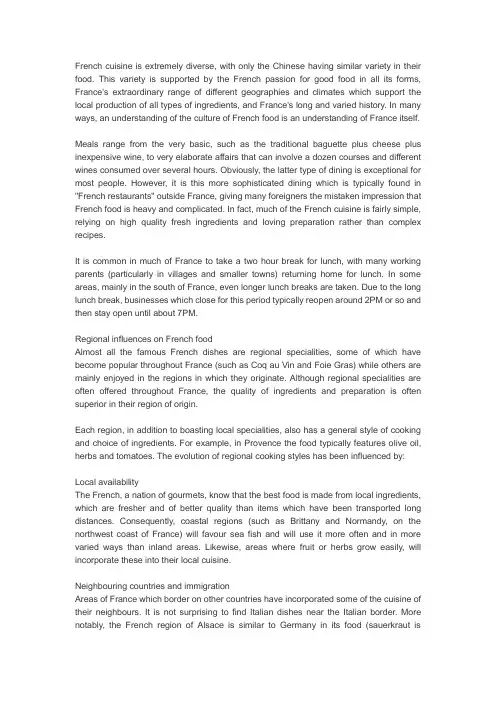
French cuisine is extremely diverse, with only the Chinese having similar variety in their food. This variety is supported by the French passion for good food in all its forms, France's extraordinary range of different geographies and climates which support the local production of all types of ingredients, and France's long and varied history. In many ways, an understanding of the culture of French food is an understanding of France itself.Meals range from the very basic, such as the traditional baguette plus cheese plus inexpensive wine, to very elaborate affairs that can involve a dozen courses and different wines consumed over several hours. Obviously, the latter type of dining is exceptional for most people. However, it is this more sophisticated dining which is typically found in "French restaurants" outside France, giving many foreigners the mistaken impression that French food is heavy and complicated. In fact, much of the French cuisine is fairly simple, relying on high quality fresh ingredients and loving preparation rather than complex recipes.It is common in much of France to take a two hour break for lunch, with many working parents (particularly in villages and smaller towns) returning home for lunch. In some areas, mainly in the south of France, even longer lunch breaks are taken. Due to the long lunch break, businesses which close for this period typically reopen around 2PM or so and then stay open until about 7PM.Regional influences on French foodAlmost all the famous French dishes are regional specialities, some of which have become popular throughout France (such as Coq au Vin and Foie Gras) while others are mainly enjoyed in the regions in which they originate. Although regional specialities are often offered throughout France, the quality of ingredients and preparation is often superior in their region of origin.Each region, in addition to boasting local specialities, also has a general style of cooking and choice of ingredients. For example, in Provence the food typically features olive oil, herbs and tomatoes. The evolution of regional cooking styles has been influenced by:Local availabilityThe French, a nation of gourmets, know that the best food is made from local ingredients, which are fresher and of better quality than items which have been transported long distances. Consequently, coastal regions (such as Brittany and Normandy, on the northwest coast of France) will favour sea fish and will use it more often and in more varied ways than inland areas. Likewise, areas where fruit or herbs grow easily, will incorporate these into their local cuisine.Neighbouring countries and immigrationAreas of France which border on other countries have incorporated some of the cuisine of their neighbours. It is not surprising to find Italian dishes near the Italian border. More notably, the French region of Alsace is similar to Germany in its food (sauerkraut ispopular) and wine, partly due to it currently bordering on Germany and partly due to it having been part of Germany at various points in its history (the border has moved back and forth with various wars). In parts of the south which have a large North African immigrant population one can enjoy the cuisine which they have imported from their original countries.History and economic conditionsThe culture, lifestyle and economic conditions over a long period of time have formed the development of local food traditions. The rich meat dishes and cream sauces of Burgundy are not only due to Burgundian excellence in raising cattle, but in large part to the economic prosperity of this region over several centuries. On the other hand, mountain regions excel in firm cheeses, which allow food to be preserved over the long and difficult winters, and can be produced from mountain livestock which historically were the main means of support for many families in economically limited areas.In all parts of France one will find a range of dishes, both in restaurants and in homes, which extends far beyond the regional specialities. However, in much of France the regional influences in terms of ingredients and cooking are marked. The most available food and the best cooking tend to be those produced from local ingredients and using local recipes. Therefore, the decision of where to visit or live in France tends to influence which types of food one will enjoy.The French Mediterranean uses olive oil, herbs and tomatoes in many of its dishes. The cuisine of northwest France uses butter, soured cream (crème fraiche) and apples. The cuisine of northeast France (Alsace, and to a lesser extent Lorraine) has a strong German influence which includes beer and sauerkraut. Throughout the south in general there tends to be more use of vegetables and fruit (in part due to the favourable climate). Near the Atlantic coast and the Mediterranean there is a greater consumption of sea food, while inland areas favoured by rivers (e.g. the Loire valley) use more fresh water fish.The Italian connectionAny discussion of the influences on French cuisine would be incomplete without recognising the historical contribution of Italy to the development of French cooking. In 1533, Catherine De Medicis (a Florentine princess) married Henry duc d'Orleans (who became King Henry II or France). At this point, France was not know for its food or food culture. Catherine brought an entourage of Italian chefs with her to France, who introduced to France a variety of dishes, food preparation and dining practices. Although France and Italy obviously have evolved very different food cultures, both before and since this contribution, much of France's current food culture can be traced back to this time.Cooking stylesEvery region of France has its own distinctive traditions in terms of ingredients and preparation (see France Regions for further information). On top of this, there are threegeneral approaches which compete with each other:Classical French cuisine (also known in France as cuisine bourgeoise).This includes all the classical French dishes which were at one time regional, but are no longer specifically regional. Food is rich and filling, with many dishes using cream-based sauces.Haute cuisineIt is classical French cuisine taken to its most sophisticated and extreme. Food is elegant, elaborate and generally rich. Meals tend to be heavy, especially due to the use of cream and either large portions or many smaller portions. There is a strong emphasis on presentation (in particular, vegetables tend to be cut with compulsive precision and uniformity). The finest ingredients are used, and the meal is correspondingly expensive.Cuisine Nouvelle.This style developed in the 1970s, as a reaction against the classical school of cooking. The food is simpler and lighter. Portions are smaller and less rich; the heavy cream sauces of the classical approach are particularly avoided. Cooking is less elaborate and quicker, with more emphasis on local and seasonal ingredients.Cuisine du terroir.This focuses on regional specialities and is somewhat more rustic in nature. Local produce and food traditions are the main focus.Each of these three traditions are strongly represented in France, with each having its supporters and specialist restaurants. At the moment, Cuisine Nouvelle is less popular than it was, while Cuisine du terroir has grown in popularity in recent years.Wine and cheeseAside from bread and water, the most common accompaniments to a French meal are wine and cheese. Unlike other countries, in France wine is considered a standard part of everyday meals, and is neither expensive nor reserved for special occasions. With everyday meals, ordinary wines are served, although it is expected that the style of wine match the style of food.In addition to its use in cooking, cheese is often served as a course in itself. In this case, it is served after the main meal but before dessert. This typically consists of a platter with three or four different cheeses, from which guests can slice pieces according to their preferences. Sliced bread (e.g. slices of a baguette) are typically provided at the same time.Restaurant guidesThe most famous and successful restaurant guide in France is the Michelin Guide Rouge, which has approximately 50% market share. It has enormous influence; the award of asingle star by the Guide Rouge to a restaurant can add 25% to its turnover and the loss of a star can mean financial ruin for a restaurant.The Guide Rouge is both a restaurant guide and a hotel guide, although its better known for the former. For the towns in the Guide Rouge there is a list of the main tourist attractions and for the larger towns there is a map. In addition to having one in the house it is handy to have one in the car (e.g. if you are unexpectedly delayed on a journey and need to find a good local restaurant).Although the Guide Rouge does not provide exact details on the criteria they use for rating restaurants, there are a number of factors beside the quality of food: service, atmosphere and value are some of the other considerations. This perhaps explains our experience that not all restaurants with the same overall rating have the same quality of food, one restaurant may have tremendous atmosphere and average food while another with the same rating may have exceptional food but little atmosphere. The Guide Rouge sometimes makes a few comments under a recommended restaurant; these are worth reading as they give an indication of what aspect of the restaurant impressed the reviewer. The comments sometimes note specialities of the house, which are often the best items on the menu.参考译文:法国的美食是非常多样的,只有中国有与之匹敌的食品种类。
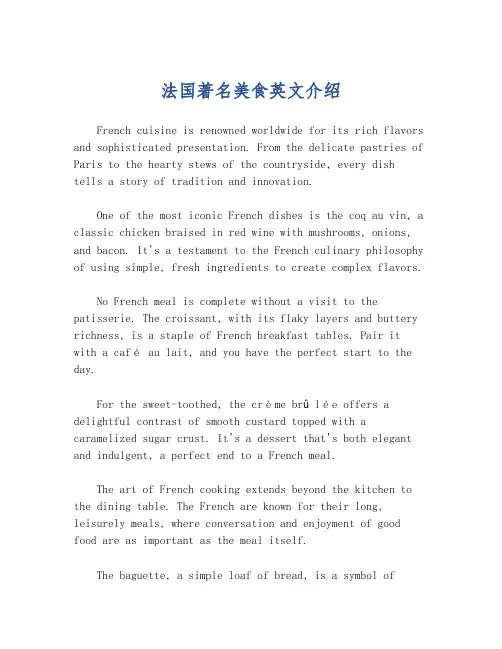
法国著名美食英文介绍French cuisine is renowned worldwide for its rich flavors and sophisticated presentation. From the delicate pastries of Paris to the hearty stews of the countryside, every dishtells a story of tradition and innovation.One of the most iconic French dishes is the coq au vin, a classic chicken braised in red wine with mushrooms, onions, and bacon. It's a testament to the French culinary philosophy of using simple, fresh ingredients to create complex flavors.No French meal is complete without a visit to the patisserie. The croissant, with its flaky layers and buttery richness, is a staple of French breakfast tables. Pair it with a café au lait, and you have the perfect start to the day.For the sweet-toothed, the crème brûlée offers a delightful contrast of smooth custard topped with a caramelized sugar crust. It's a dessert that's both elegant and indulgent, a perfect end to a French meal.The art of French cooking extends beyond the kitchen to the dining table. The French are known for their long, leisurely meals, where conversation and enjoyment of good food are as important as the meal itself.The baguette, a simple loaf of bread, is a symbol ofFrench baking. Freshly baked and crusty on the outside with a soft interior, it's a versatile accompaniment to any meal.Escargot, or snails cooked in garlic butter, may seem an unusual choice, but it's a delicacy that has been enjoyed in France for centuries. It's a bold flavor that challenges the palate and is a must-try for adventurous eaters.Cheese is an integral part of French cuisine, with hundreds of varieties to explore. From the pungent Roquefort to the creamy Brie, each cheese has its own unique characteristics and is often enjoyed with a glass of wine.Lastly, the French love for wine is evident in their gastronomy. Pairing the right wine with food is an art form, enhancing the flavors of both and creating a harmonious dining experience.。
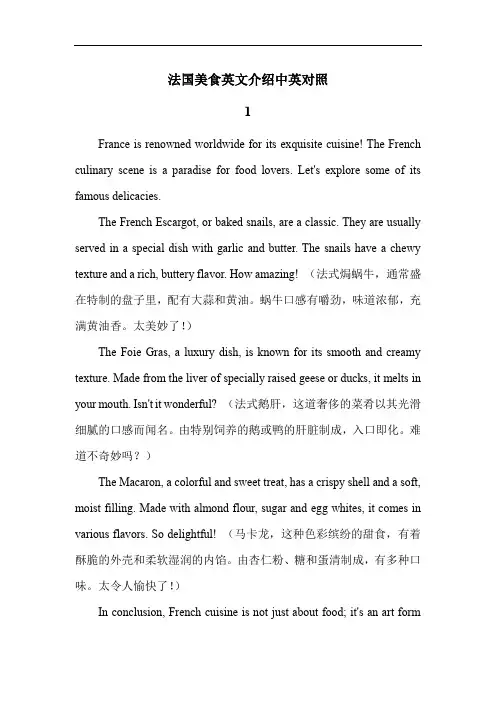
法国美食英文介绍中英对照1France is renowned worldwide for its exquisite cuisine! The French culinary scene is a paradise for food lovers. Let's explore some of its famous delicacies.The French Escargot, or baked snails, are a classic. They are usually served in a special dish with garlic and butter. The snails have a chewy texture and a rich, buttery flavor. How amazing! (法式焗蜗牛,通常盛在特制的盘子里,配有大蒜和黄油。
蜗牛口感有嚼劲,味道浓郁,充满黄油香。
太美妙了!)The Foie Gras, a luxury dish, is known for its smooth and creamy texture. Made from the liver of specially raised geese or ducks, it melts in your mouth. Isn't it wonderful? ((法式鹅肝,这道奢侈的菜肴以其光滑细腻的口感而闻名。
由特别饲养的鹅或鸭的肝脏制成,入口即化。
难道不奇妙吗?)The Macaron, a colorful and sweet treat, has a crispy shell and a soft, moist filling. Made with almond flour, sugar and egg whites, it comes in various flavors. So delightful! (马卡龙,这种色彩缤纷的甜食,有着酥脆的外壳和柔软湿润的内馅。
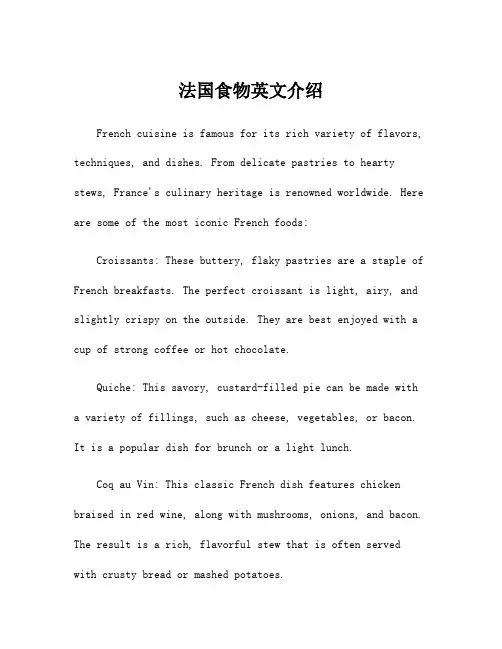
法国食物英文介绍French cuisine is famous for its rich variety of flavors, techniques, and dishes. From delicate pastries to hearty stews, France's culinary heritage is renowned worldwide. Here are some of the most iconic French foods:Croissants: These buttery, flaky pastries are a staple of French breakfasts. The perfect croissant is light, airy, and slightly crispy on the outside. They are best enjoyed with a cup of strong coffee or hot chocolate.Quiche: This savory, custard-filled pie can be made with a variety of fillings, such as cheese, vegetables, or bacon. It is a popular dish for brunch or a light lunch.Coq au Vin: This classic French dish features chicken braised in red wine, along with mushrooms, onions, and bacon. The result is a rich, flavorful stew that is often served with crusty bread or mashed potatoes.Boeuf Bourguignon: Similar to coq au vin, this dish consists of beef braised in red wine, along with carrots, onions, and mushrooms. It is a hearty, comforting meal that is perfect for a cold winter's day.Bouillabaisse: Originating from the Provence region, this fish stew is made with a variety of seafood, such as fish, shellfish, and crustaceans. The broth is flavored with tomatoes, saffron, and fennel, resulting in a fragrant and flavorful dish.Foie Gras: This controversial delicacy is made from the liver of a duck or goose that has been specially fattened. It is often served as a pâté or in terrine form, and istypically enjoyed with toast or brioche.Ratatouille: This colorful vegetable stew is made with tomatoes, eggplant, zucchini, onions, and peppers, along with a variety of herbs and spices. It is a popular vegetarian dish that can be enjoyed on its own or as a side dish.Crème Brûlée: This creamy, vanilla-flavored dessert is topped with a layer of caramelized sugar, creating a satisfying contrast of textures. It is a popular dessert in French restaurants around the world.Macarons: These delicate, colorful almond meringue cookies are filled with a variety of flavors, such as chocolate, raspberry, or pistachio. They are a popular treat for special occasions or as a gift.French cuisine is also known for its emphasis on fresh, high-quality ingredients and meticulous preparation. Whether you are enjoying a simple baguette with cheese or a decadent multi-course meal, French food is a celebration of flavor, tradition, and artistry.。
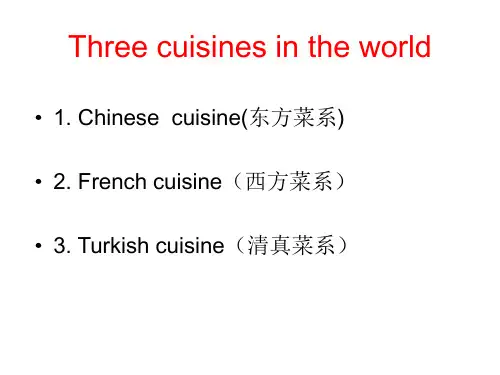
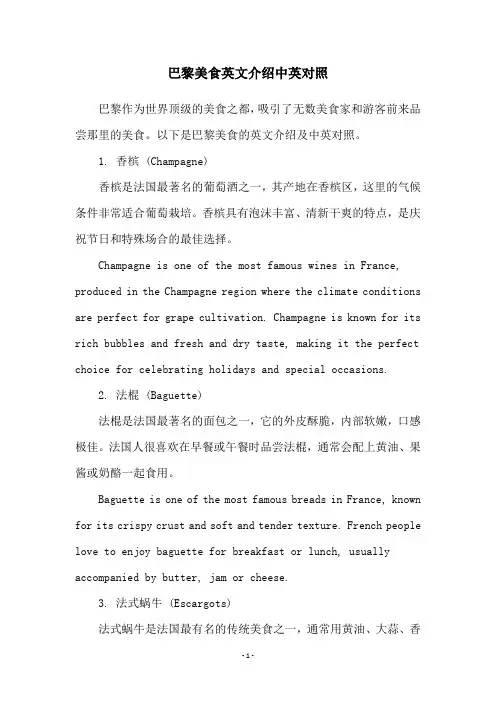
巴黎美食英文介绍中英对照巴黎作为世界顶级的美食之都,吸引了无数美食家和游客前来品尝那里的美食。
以下是巴黎美食的英文介绍及中英对照。
1. 香槟 (Champagne)香槟是法国最著名的葡萄酒之一,其产地在香槟区,这里的气候条件非常适合葡萄栽培。
香槟具有泡沫丰富、清新干爽的特点,是庆祝节日和特殊场合的最佳选择。
Champagne is one of the most famous wines in France, produced in the Champagne region where the climate conditions are perfect for grape cultivation. Champagne is known for its rich bubbles and fresh and dry taste, making it the perfect choice for celebrating holidays and special occasions.2. 法棍 (Baguette)法棍是法国最著名的面包之一,它的外皮酥脆,内部软嫩,口感极佳。
法国人很喜欢在早餐或午餐时品尝法棍,通常会配上黄油、果酱或奶酪一起食用。
Baguette is one of the most famous breads in France, known for its crispy crust and soft and tender texture. French people love to enjoy baguette for breakfast or lunch, usually accompanied by butter, jam or cheese.3. 法式蜗牛 (Escargots)法式蜗牛是法国最有名的传统美食之一,通常用黄油、大蒜、香草和白葡萄酒烹制而成。
蜗牛的口感鲜美,清香扑鼻,是法国美食文化的代表之一。
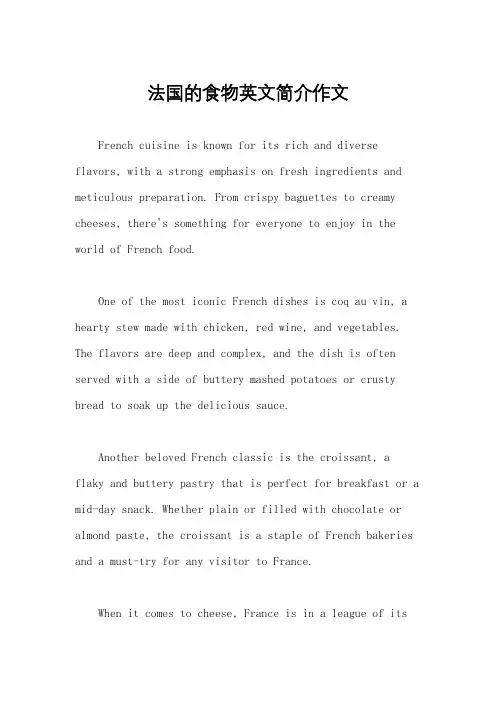
法国的食物英文简介作文French cuisine is known for its rich and diverse flavors, with a strong emphasis on fresh ingredients and meticulous preparation. From crispy baguettes to creamy cheeses, there's something for everyone to enjoy in the world of French food.One of the most iconic French dishes is coq au vin, a hearty stew made with chicken, red wine, and vegetables. The flavors are deep and complex, and the dish is often served with a side of buttery mashed potatoes or crusty bread to soak up the delicious sauce.Another beloved French classic is the croissant, aflaky and buttery pastry that is perfect for breakfast or a mid-day snack. Whether plain or filled with chocolate or almond paste, the croissant is a staple of French bakeries and a must-try for any visitor to France.When it comes to cheese, France is in a league of itsown. From creamy brie to tangy Roquefort, there's a cheese for every palate. Pair it with a glass of wine and some crusty bread, and you have the perfect French snack.No discussion of French cuisine would be complete without mentioning escargot, or snails. While it may sound intimidating, these little mollusks are a delicacy in France, often served in a garlicky butter sauce and enjoyed with a glass of white wine.Of course, no trip to France would be complete without indulging in some decadent desserts. From delicate macarons to rich chocolate mousse, French desserts are a feast for the senses and a perfect way to end a delicious meal.。
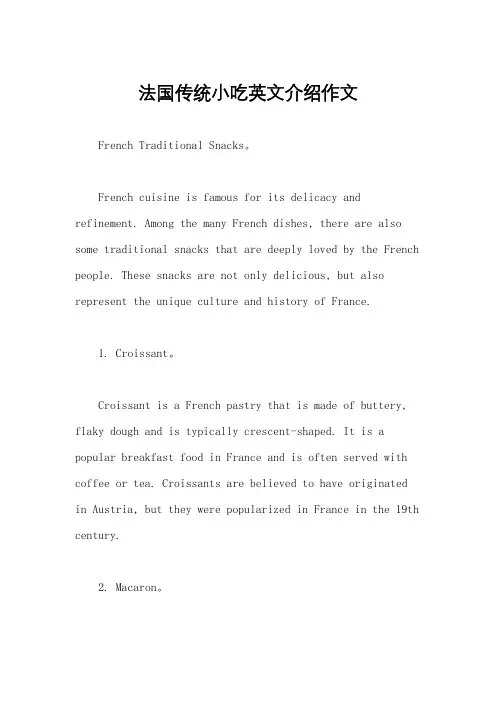
法国传统小吃英文介绍作文French Traditional Snacks。
French cuisine is famous for its delicacy and refinement. Among the many French dishes, there are also some traditional snacks that are deeply loved by the French people. These snacks are not only delicious, but also represent the unique culture and history of France.1. Croissant。
Croissant is a French pastry that is made of buttery, flaky dough and is typically crescent-shaped. It is a popular breakfast food in France and is often served with coffee or tea. Croissants are believed to have originated in Austria, but they were popularized in France in the 19th century.2. Macaron。
Macarons are small, round cookies that are made of almond flour, sugar, and egg whites. They are typicallyfilled with buttercream or ganache and come in a variety of flavors, such as chocolate, raspberry, and pistachio. Macarons have been a French delicacy since the 16th century.3. Crème Brûlée。
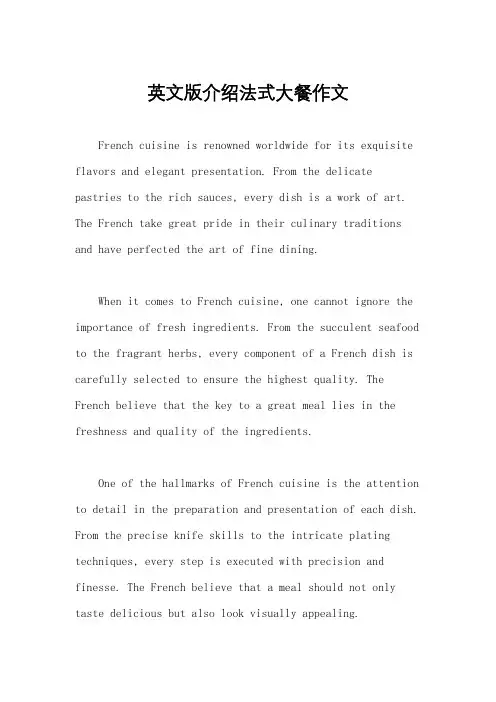
英文版介绍法式大餐作文French cuisine is renowned worldwide for its exquisite flavors and elegant presentation. From the delicatepastries to the rich sauces, every dish is a work of art. The French take great pride in their culinary traditions and have perfected the art of fine dining.When it comes to French cuisine, one cannot ignore the importance of fresh ingredients. From the succulent seafood to the fragrant herbs, every component of a French dish is carefully selected to ensure the highest quality. The French believe that the key to a great meal lies in the freshness and quality of the ingredients.One of the hallmarks of French cuisine is the attention to detail in the preparation and presentation of each dish. From the precise knife skills to the intricate plating techniques, every step is executed with precision and finesse. The French believe that a meal should not only taste delicious but also look visually appealing.French cuisine is also known for its rich and flavorful sauces. From the velvety hollandaise to the tangybéarnaise, sauces play a crucial role in enhancing the flavors of a dish. The French have mastered the art of sauce-making, using a combination of ingredients and cooking techniques to create a harmonious blend of flavors.In addition to the sauces, French cuisine is also famous for its use of herbs and spices. From the fragrant thyme to the aromatic lavender, herbs are used to add depth and complexity to a dish. The French believe that the right combination of herbs and spices can elevate a simple dish to new heights.French desserts are a true indulgence for the senses. From the light and airy soufflés to the rich and creamycrème brûlée, French pastries are a delight to behold. The French have a sweet tooth and take great pride in their pastry-making skills. Each dessert is carefully crafted to perfection, with layers of flavors and textures that leave a lasting impression.In conclusion, French cuisine is a true culinary masterpiece. From the fresh ingredients to the attention to detail, every aspect of a French dish is carefully considered. The French take great pride in their culinary traditions and have elevated food to an art form. Whetherit's a simple bistro meal or an elaborate fine dining experience, French cuisine never fails to impress.。
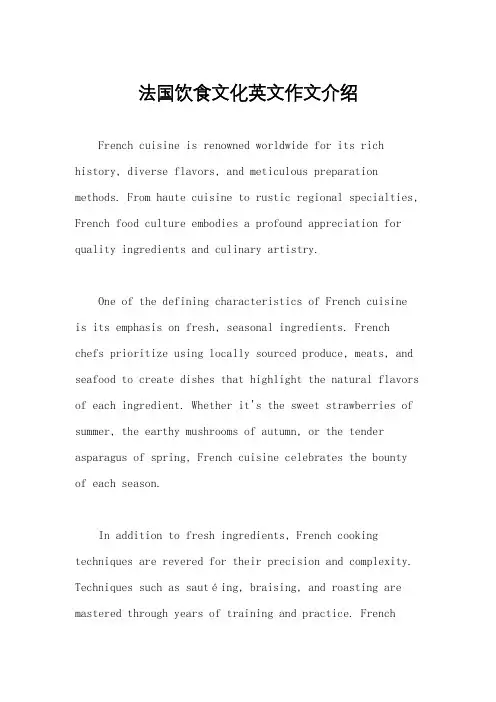
法国饮食文化英文作文介绍French cuisine is renowned worldwide for its rich history, diverse flavors, and meticulous preparation methods. From haute cuisine to rustic regional specialties, French food culture embodies a profound appreciation for quality ingredients and culinary artistry.One of the defining characteristics of French cuisine is its emphasis on fresh, seasonal ingredients. French chefs prioritize using locally sourced produce, meats, and seafood to create dishes that highlight the natural flavors of each ingredient. Whether it's the sweet strawberries of summer, the earthy mushrooms of autumn, or the tender asparagus of spring, French cuisine celebrates the bounty of each season.In addition to fresh ingredients, French cooking techniques are revered for their precision and complexity. Techniques such as sautéing, braising, and roasting are mastered through years of training and practice. Frenchchefs are known for their attention to detail, from the precise julienne of vegetables to the perfectly executed reduction sauces that accompany many dishes.Perhaps one of the most iconic aspects of French cuisine is its bread and pastry tradition. France is home to a vast array of breads, from crusty baguettes to buttery croissants. Each region has its own specialty bread, reflecting the unique culinary heritage of that area. French pastries are equally diverse, with classics likeéclairs, macarons, and tarte Tatin delighting dessert lovers around the world.French meals are typically served in multiple courses, starting with hors d'oeuvres or appetizers, followed by a main course, cheese course, and dessert. This structured approach to dining allows diners to savor each dish and appreciate the progression of flavors throughout the meal. Wine is also an integral part of French gastronomy, with each region producing its own distinct varieties to complement local cuisine.Regional diversity is another hallmark of French food culture. From the hearty stews of Normandy to the fragrant bouillabaisse of Provence, each region of France has its own culinary traditions and specialties. This diversity is celebrated in festivals and food markets across the country, where visitors can sample a wide range of regional delicacies.Overall, French cuisine is a testament to the country's rich cultural heritage and culinary innovation. Whether enjoying a simple meal at a neighborhood bistro or diningat a Michelin-starred restaurant, the essence of French cooking shines through in every dish. With its emphasis on quality ingredients, meticulous preparation, and regional diversity, French cuisine continues to captivate foodlovers around the globe.。

英文短文关于法国的食物作文English: French cuisine is renowned around the world for its exquisite flavors and diversity. From rich sauces to delicate pastries, there is something to satisfy every palate in France. One of the most iconic dishes is coq au vin, which consists of chicken cooked in red wine with mushrooms, onions, and bacon. Another popular dish is boeuf bourguignon, a hearty beef stew cooked with red wine, mushrooms, and carrots. French bread, especially baguettes and croissants, are an essential part of every meal and are perfect for soaking up delicious sauces. For dessert, one cannot forget about the decadent crèmebrûlée, a creamy custard topped with a layer of caramelized sugar. French cheeses are also a must-try, with varieties like brie, camembert, and Roquefort delighting cheese lovers worldwide. Overall, French cuisine is a true art form that celebrates quality ingredients and meticulous preparation techniques.中文翻译: 法国菜在世界各地都以其精致的口味和多样性而闻名。
英文短文关于法国的食物作文France is renowned worldwide for its exquisite cuisine, known for its fine dining and delectable pastries. 法国以其精致美食而闻名于世,以其精美的餐饮和美味的糕点而著称。
French cuisine is a rich tapestry of flavors and techniques, influenced by a long history of culinary tradition. 法国烹饪是由丰富的口味和技术组成的,受长期烹饪传统的影响。
One iconic dish from France is coq au vin, a hearty chicken stew cooked with red wine, mushrooms, and onions. 法国的一道标志性菜肴是红酒烩鸡,这是一道用红酒、蘑菇和洋葱烹制的浓郁鸡肉炖菜。
Another famous French dish is ratatouille, a vegetable stew made with tomatoes, zucchini, eggplant, and bell peppers. 另一道著名的法国菜是蔬菜煲,用番茄、西葫芦、茄子和甜椒做成。
French pastries are also a highlight of the country's culinary offerings, with classics like croissants, éclairs, and macarons delighting tastebuds worldwide. 法国糕点也是该国烹饪之精华,诸如羊角面包、闪电泡芙和马卡龙等经典品种令世界各地的味蕾愉悦。
The French take great pride in their cuisine, considering it an integral part of their cultural identity. 法国人对自己的烹饪非常自豪,认为烹饪是他们文化身份不可或缺的一部分。
The Charms of French CuisineFrance, a country renowned for its rich cultural heritage and elegant lifestyle, is also famous for its cuisine that has captivated the palates of food lovers worldwide. French cooking, often referred to as cuisine française, is not just about the deliciousness of the food but also an art form that combines flavors, textures, and visual presentations.The foundation of French cooking lies in its use of fresh, seasonal ingredients. French chefs are masters at selecting the finest produce from their local markets, whether it's the succulent meats, the ripe fruits, or the vibrant vegetables. This attention to detail extends to every step of the cooking process, from the meticulous preparation of ingredients to the precise timing of cooking techniques.One of the hallmarks of French cuisine is its emphasis on sauces and stocks. These flavorful liquids, often made from bones, vegetables, and herbs, form the backbone of many French dishes, adding depth and complexity to thefinal presentation. The careful balancing of acids, fats,and seasonings in these sauces is what gives French foodits unique and irresistible taste.Another noteworthy aspect of French cooking is its use of butter and cream. These ingredients, while rich inflavor and texture, are used sparingly, ensuring that they enhance the overall dish without overpowering it. Theresult is dishes that are both indulgent and elegant, satisfying the taste buds while also appealing to the eyes. Bread is also a staple in French cuisine. The French have a long-standing love affair with bread, and it's no surprise that they have perfected the art of baking it. From the crispy crusts to the soft, fluffy interiors, French breads are as much a part of the dining experience as the main course itself.But it's not just the ingredients and techniques that make French cuisine special. It's also the way it's presented. French dining is an experience that involves all the senses, and the visual aspect of a dish is just as important as its taste. Dishes are often arranged with great care, sometimes even resembling works of art,reflecting the French belief that food should be enjoyed as much with the eyes as with the mouth.In conclusion, French cuisine is not just about food;it's an embodiment of French culture and lifestyle. It's about the love for fresh, seasonal ingredients, theattention to detail in preparation and cooking, the artful presentation of dishes, and the enjoyment of dining as a social experience. French food is not just something to eat; it's an experience to be savored and remembered.**法国美食的魅力**法国,一个因丰富的文化遗产和优雅的生活方式而闻名的国家,其美食也吸引了世界各地美食爱好者的味蕾。
法国的食物作文英文英文:When it comes to French food, my mouth waters just thinking about it. French cuisine is known for its rich flavors, fresh ingredients, and elegant presentation. From croissants and baguettes to escargot and coq au vin, French food has something for everyone.One of my favorite French dishes is ratatouille. This vegetable stew is made with eggplant, zucchini, bell peppers, onions, and tomatoes. It's seasoned with garlic, thyme, and basil and simmered until all the flavors meld together. It's a hearty and healthy dish that's perfect for a cozy night in.Another classic French dish is bouillabaisse, a fish soup that originated in Marseille. It's made with a variety of fish, shellfish, and vegetables, and flavored with saffron and fennel. It's usually served with a side ofrouille, a garlicky mayonnaise that's spread on crusty bread.French food also has a reputation for being indulgent and decadent, and there's no shortage of desserts to satisfy your sweet tooth. From crème brûlée and macarons to tarte tatin and éclairs, French desserts are rich, creamy, and absolutely delicious.中文:说到法国美食,我就流口水。
法国的美食sbails英文介绍全文共3篇示例,供读者参考篇1French cuisine is known around the world for its delicious flavors, rich ingredients, and elegant presentation. One of the most popular dishes in French cuisine is escargot, which are snails cooked in garlic butter and herbs. This dish is a delicacy in France and is often served as an appetizer in fine dining restaurants.Escargot are typically prepared by first removing the snails from their shells and cleaning them thoroughly. They are then cooked in a mixture of butter, garlic, shallots, parsley, and white wine until they are tender and flavorful. The snails are then placed back into their shells and served piping hot with crusty bread to soak up the delicious sauce.The texture of escargot is often described as chewy and slightly rubbery, but the real pleasure comes from the rich and savory flavors of the garlic butter and herbs. The combination of butter, garlic, and herbs creates a fragrant and delicious sauce that enhances the natural taste of the snails.Escargot can be enjoyed as an appetizer or a main course, and are often served with a glass of dry white wine. In France, escargot is a popular dish during the holiday season, and is often included in traditional Christmas and New Year's Eve menus.Overall, escargot is a unique and delicious dish that represents the elegance and sophistication of French cuisine. Whether you are a food enthusiast or a culinary adventurer, trying escargot is a must-do experience when visiting France.篇2French cuisine is renowned worldwide for its exquisite taste, rich flavors, and diverse offerings. From decadent pastries to savory cheeses, France has a wealth of culinary treasures to tantalize the taste buds of food enthusiasts.One of the most iconic French delicacies is escargot, a dish of cooked land snails. Served in their shells with garlic butter or parsley, these tender morsels are a true delicacy that embodies the essence of French haute cuisine. The unique texture and flavor of escargot make it a must-try for any foodie visiting France.Another classic French dish is the bouillabaisse, a traditional Provencal fish stew that originated in Marseille. Made with avariety of fresh seafood such as fish, shellfish, and herbs, bouillabaisse is a true seafood lover's delight. The rich flavors and aromatic broth of this dish showcase the culinary expertise of French chefs.No discussion of French cuisine would be complete without mention of the famous croissant. This buttery, flaky pastry is a staple of French breakfasts and cafés around the world. Whether enjoyed plain or filled with chocolate or almond paste, the croissant is a beloved symbol of French culinary excellence.Cheese lovers will find themselves in paradise in France, home to over 400 different types of cheese. From creamy Brie to pungent Roquefort, French cheeses offer a wide range of flavors and textures to suit every palate. Pair with a glass of wine and some fresh baguette for a quintessentially French dining experience.Of course, no discussion of French cuisine would be complete without mention of the country's world-famous wines. France is known for producing some of the finest wines in the world, from Bordeaux to Burgundy. Whether you prefer a crisp Chardonnay or a robust Cabernet Sauvignon, French wines offer a perfect complement to any meal.In conclusion, French cuisine is a true culinary delight that showcases the country's rich culinary heritage and passion for food. From escargot to croissants, French dishes are a feast for the senses that will leave you craving more. Whether you're a seasoned foodie or just starting to explore the world of French cuisine, there is something for everyone to enjoy in the gastronomic paradise that is France.篇3French cuisine is renowned worldwide for its exquisite flavors, delicate techniques, and rich history. Among the plethora of dishes that make up this revered culinary tradition, one standout is escargot - a dish made with snails, known in French as "escargots de Bourgogne."The French have been consuming snails for centuries, with evidence of their consumption dating back to Roman times. Escargot became particularly popular in France during the Middle Ages when snails were plentiful and considered a cheap source of protein for peasants and farmers.To prepare escargot, the snails are removed from their shells, cleaned, and then cooked in a broth typically made with garlic, herbs, and butter. The cooked snails are then placed back intotheir shells, topped with the flavorful broth, and baked in the oven until they are sizzling hot and ready to be enjoyed.Escargot is often served as an appetizer in French restaurants, and it is typically accompanied by crusty bread for dipping into the delicious garlic and herb-infused butter. The combination of the tender snails with the rich, buttery sauce creates a decadent and luxurious experience that is unique to French cuisine.While some may be hesitant to try escargot due to its unusual main ingredient, those who dare to give it a taste are often pleasantly surprised by its delicate flavor and tender texture. Escargot is a true delicacy that epitomizes the sophistication and elegance of French gastronomy.In conclusion, escargot is a quintessential French dish that exemplifies the artistry and culinary expertise of French chefs. Its rich history, complex flavors, and luxurious presentation make it a must-try for anyone looking to experience the best of French cuisine. So next time you find yourself in a French restaurant, be adventurous and order a plate of escargot - you won't be disappointed!。
French cuisine has evolved over centuries. The national cuisine started forming in the Middle Ages due to the influence of the work of skilled chefs and various social and political movements. Over the years the styles of French cuisine have been given different names, and have been modified by various master-chefs. During their lifetimes, these chefs have been held in high regard for contributions to the culture of the country. The national cuisine developed primarily in the city of Paris with the chefs to French royalty, but eventually it spread throughout the country and was even exported overseas.Common fruits include oranges, tomatoes, peaches, apples, pears, strawberries, redcurrant. Varieties of meat consumed include (chicken), (turkey), (duck), (goose, the source of foie gras), (beef), (pork), (lamb), (rabbit), (horse), (frog).Beverages(饮料)Traditionally, France has been a culture of wine consumption, but this has lessened with time. Since the 1960s, per capita wine consumption has dropped by 50 percent and continues to decline, primarily due to less consumption of low quality wines with meals.[13] Beer is especially popular with the young. Other popular alcoholic drinks include pastis, an aniseed-flavored beverage diluted with cold water.Breakfast: (breakfast) is often a quick meal consisting of (slices) of buttered French bread, croissants([krwɑ:sɔŋ]) or chocolate along with coffee or tea. Children often drink hot chocolate in bowls along with their breakfast.Lunch: In large cities a majority of working people and students eat their lunch at a corporate or school cafeteria, which normally serve complete meals as described above; it is therefore not usual for students to bring their own lunch food. It is common for white-collar workers to be given lunch vouchers as part of their employee benefits. These can be used in most restaurants, supermarkets and traiteurs; however workers having lunch in this way typically do not eat all three dishes of a traditional lunch due to price and time considerations. In smaller cities and towns, some working people leave their workplaces to return home for lunch, generating four rush hours during the day. Finally, an also popular alternative especially among blue-collar workers is to lunch on a sandwich possibly followed with a dessert; both dishes can be found ready-made at bakeries and supermarkets for budget prices.(Dinner) often consists of three courses, (introductory course, often soup), plat principal (main course), and a cheese course or dessert, sometimes with a salad offered before the cheese or dessert. Yogurt may replace the cheese course, while a normal everyday dessert would be fresh fruit. The meal is often accompanied by bread, wine and mineral water. Wine consumption has been dropping recently amongst young people. Fruit juice consumption has risen from 25.6% in 1996 to 31.6% in 2002. Main meat courses are often served with vegetables, along with rice or pasta.[11]:82 Restaurants often open at 7:30pm for dinner, and stop taking orders between the hours of 10:00pm and 11:00 pm. Many restaurants close for dinner on Sundays.Cafeteria:primarily locations for coffee and alcoholic drinks. Tables and chairs are usually set outside. Cafés often open early in the morning and shut down around nine at night.。